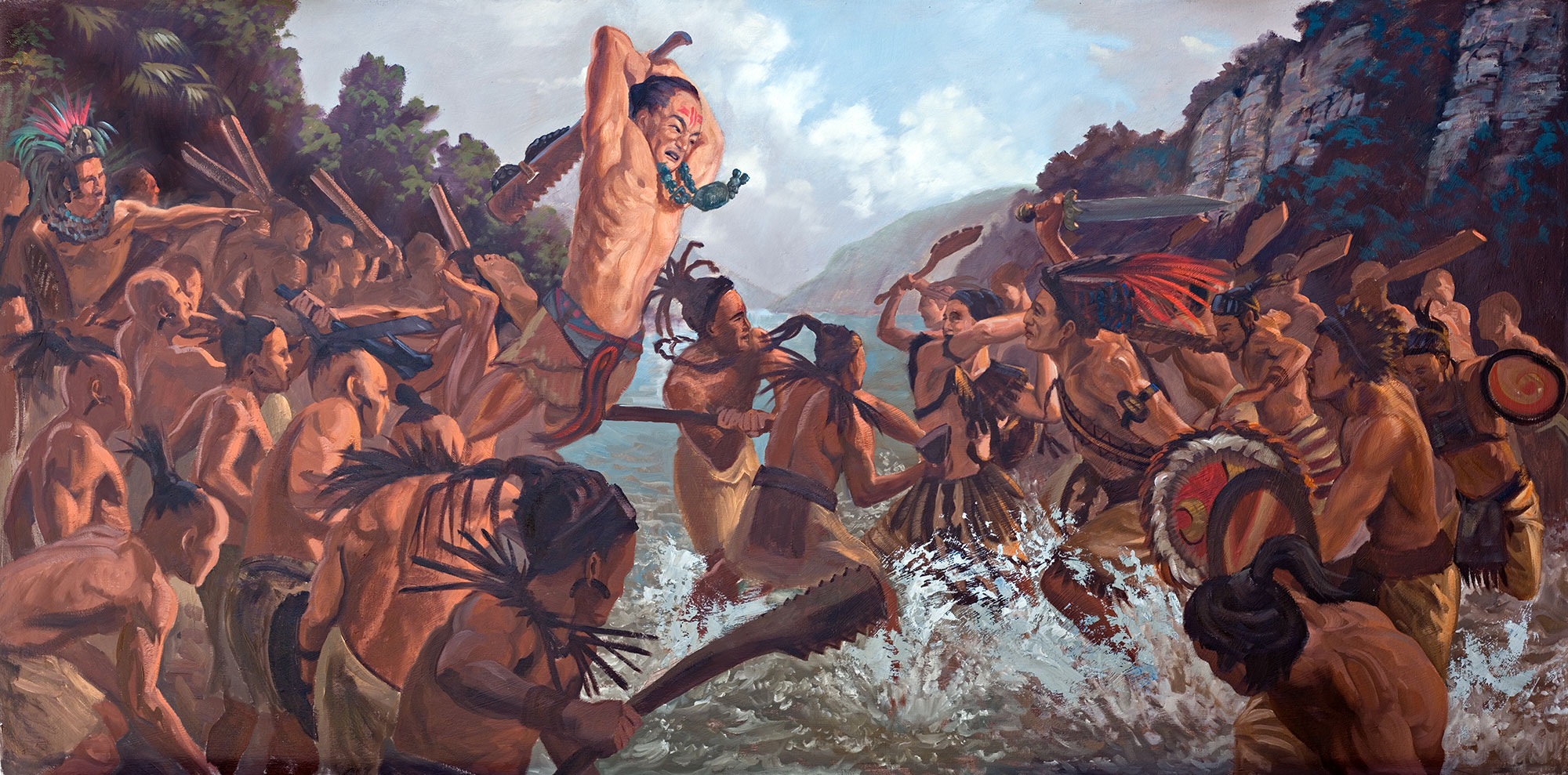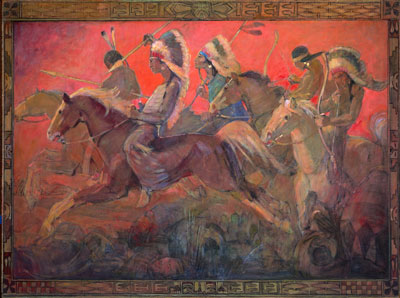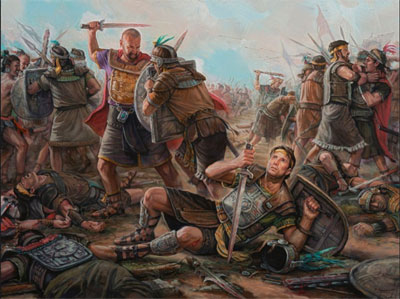
The Know
The Book of Mormon is a book saturated with warfare. The grim reality for ancient peoples was that religious, political, and cultural ideologies were frequently enforced through war. Even before bloodshed broke out between the Nephites and Lamanites in the New World, Lehi’s party was exposed to a violent rivalry between Nephi and his brothers, Laman and Lemuel.
John W. Welch has identified at least 15 major wars or conflicts that spanned the history of Book of Mormon peoples (see chart below).1 A fair portion of the book of Alma (Alma 2–3, 16, 24–25, 43–62) sometimes provides excruciating details concerning the wars between the Lamanites and Nephites. Unforgettable is the tragic downfall of the Nephites at the battle of Cumorah, which resulted in unparalleled death and carnage (Mormon 1–6).
| Name | Sources | Date | Location | Causes | Results |
|---|---|---|---|---|---|
| The Early Tribal Wars | Jacob 1:10, 14; Enos—Omni | 6th-2nd century B.C. | Land of Nephi | Popular and fraternal hatred | Nephite ideals and culture did not last; left the land of Nephi |
| The Wars of King Laman’s Son | Mosiah 9-10; Omni 1:24; Words of Mormon 1:13-14 | About 160-150 B.C. | City of Nephi and land of Zarahemla | Lamanite fear of growing Nephite strength | Benjamin’s victory unified and established the land of Zarahemla as Nephite territory |
| The War of Amlici | Alma 2-3 | Fifth year Reign of the Judges [R.J.] (87 B.C.). | Zarahemla, hill Amnihu, and river Sidon | Transition from kingship to judgeship | An uneasy peace in Zarahemla under Alma as chief judge |
| The Destruction of Ammonihah | Alma 16:1-11; 24:1-25:14 | 11 R.J. (81 B.C.). | City of Ammonihah to the west of Zarahemla | Lamanites angry at Nehorites and their allies for causing Lamanites to kill other Lamanites | Virtual elimination of Nehorites as a political force |
| The War of Ammonite Secession | Alma 28 | 15 R.J. (77 B.C.). | Area in Zarahemla around the land of Jershon | Lamanites attacked the Nephites around the land of Jershon | Ammonites established in the land of Jershon. |
| The Zoramite War | Alma 43-44 | 18 R.J. (74 B.C.). | In the land of Manti near the head of the river Sidon | Zoramites separated from the Nephites; entered into a correspondence with the Lamanites. | Almost complete obliteration of the Zoramite army |
| The First Amalickiahite War | Alma 46-50 | 20 R.J. (72 B.C.). | Ammonihah, Noah, and the east seacoast near the narrow neck of land. | Political ambitions of Amalickiah, a Zoramite in Zarahemla | Amalickiah defeated, but he swore to return and kill Moroni. |
| The Second Amalickiahite War | Alma 51-62 | 25-31 R.J. (67-61 B.C.). | Throughout the land of Zarahemla, cities around the east sea | Return of Amalickiah | A very costly Nephite victory |
| The Rebellion of Paanchi | Helaman 1:1-13 | 40 R.J. (52 B.C.). | City of Zarahemla | Dispute over Pahoran, the son of Pahoran, becoming chief judge | Paanchi executed, Pahoran assassinated, and faction of secret murderers led by Kishkumen formed |
| The War of Tubaloth | Helaman 1:14-34 | 41 R.J. (51 B.C.). | Cities of Zarahemla | Tubaloth sought to capture the land of Zarahemla | Contributed to the political unrest, the rise of the Gadianton robbers |
| The War of Moronihah | Helaman 4 | 54, 57-62 R.J. (38, 35-30 B.C.). | Land of Zarahemla | Continuing dissension in the church, possibly sparked when Nephi became chief judge | Some dissenters returned with Lamanite support and occupied half of the Nephite lands. |
| The War of Gadianton and Kishkumen | Helaman 6:15-11:20 | 66-73 R.J. (26-19 B.C.). | The entire land, but centered in the land of Zarahemla | Assassinations of the chief judges Cezoram and his son | The war ended when Nephi declared a famine |
| The War of Giddianhi and Zemnarihah | 3 Nephi 2:11-4:28 | A.D. 13-22. | Between the lands of Bountiful and Desolation | Gadianton robbers had established strongholds in the mountains | The unification of Lamanites and Nephites against the threat of robbers |
| The Rebellion of Jacob | 3 Nephi 6:14-7:14 | A.D. 30. | Land of Zarahemla | Lachoneus took office and attempted to try the judges who had exceeded their power | Collapse of reign of judges; degeneration to tribal society |
| The Final Nephite Wars | Mormon 1–6 | Circa A.D. 320 | Land of Zarahemla and northward | Infestations of robbers; Lamanite aggression | The Lamanites annihilate the Nephite civilization |
As is true today, warfare in the ancient world took on ideological importance for both sides of a conflict. The ancient Egyptians, Hebrews, Greeks, and Romans all recorded or recounted tales of combat and war that took on nationalistic and mythic significance for them as a people.2 “Scribes often recorded the results of these wars in accounts usually intended to exalt the king and/or the nation’s god(s),” Boyd Seevers observed. “The biblical authors normally write about warfare for some theological purpose, such as illustrating faith–––or lack thereof–––in God by some Israelite leader or the nation as a whole.”3
The same is true of the ancient Maya. Archaeological investigations have determined conclusively that the Maya, Aztec, and other Mesoamerican cultures were often steeped in warfare that carried great cultural and practical significance.4 Warfare “occupied a prominent place in the mind and practice” of ancient Mesoamerican peoples. Just as it did for the Nephites, “warfare, whether real or imagined, played an important role in shaping values, meanings, and identities in the lives of the Maya, and such cultural notions, in turn, affected how war was fought or avoided.”5
This was precisely Mormon’s intention in capturing the history of Nephite warfare. Much more than simply reporting these wars like a modern journalist–––unbiased, impartial, and striving to remain morally neutral–––Mormon infused (sometimes stereotypical) moral and theological significance into his war narratives.6 Thus Mormon’s lament at the end of his records that his people were slaughtered because of their having “departed from the ways of the Lord” (Mormon 6:17). Or his forceful denunciation of Amalickiah, the Nephites’ chief enemy some centuries before Mormon’s time, as a wicked usurper, conspirator, apostate, and traitor who “by his fraud, gained the hearts of the people” (Alma 47:30).
Mormon’s focus on Nephite troop tactics, weaponry, fortifications, and the like might also easily be explained by the simple fact that Mormon himself was a military leader as much as a historian or prophet. With a professional interest in military matters, it makes sense that Mormon would knowledgeably spend time to describe the finer details of Nephite military history. Especially when these details augmented his narrative, such as when Nephite innovations in armor and fortifications granted them victory over their Lamanite foes (e.g. Alma 44:8–9; 50:10–12).7
The Why
When viewed in an ancient context, it begins to make sense why the Book of Mormon would focus so closely on war. As explained by Welch,
Wars and the politics of war were an integral part of history in the Book of Mormon. . . . Most military events in the Book of Mormon have both religious and political importance. The Nephites did not dichotomize their world between church and state as we do. Ancient peoples generally viewed war as a contest between the gods of one people and the gods of another.8
In addition to providing a glimpse into Nephite and Lamanite political and religious culture, the war chapters in the Book of Mormon can also be seen as evidence for the book’s historicity. “One powerful dimension of historicity of the Book of Mormon is the sheer complexity of the record. The amazing achievement of the Book of Mormon is not the fact that it is a big book containing numerous chapters on warfare, but the stark reality that those chapters are complicated and consistent.” Not only the book’s complexity, but also its realism is evidence in favor of its historicity.9 “The human and social events recorded in the Book of Mormon are realistic. They make sense in light of the way people and nations in fact behave.”10
These factors combine to make the war chapters in the Book of Mormon powerful for a number of reasons. They not only provide important information on the history of the Nephites and Lamanites, but also give modern readers to a window into Mormon’s thinking on how and why he presented the history of his people the way he did.
War tactics and atrocities, whether conventional or terrorist, continue to plague the world today. The causes of war and armed conflict, the sources of contention and violence, still preoccupy and perplex the minds and hearts of nations everywhere. While Mormon and his peoples proved unable to stave off the horrors of their own annihilation, their record was written as a witness and a warning to help people today all over the world learn wisdom. Its prophetic teachings—of faith in Christ, sincere repentance, obedience to righteous covenants, generous love for all mankind, and concern for children and future generations—offer messages of hope, peace, and eternal rest in the presence of God. Though ancient, the messages of the Book of Mormon could not be more relevant to the urgent needs of modern world today.
Further Reading
Brant. A. Gardner, Traditions of the Fathers: The Book of Mormon as History (Salt Lake City, UT: Greg Kofford Books, 2015), 311–324.
John W. Welch, “Why Study Warfare in the Book of Mormon?” in Warfare in the Book of Mormon, ed. Stephen D. Ricks and William J. Hamblin (Salt Lake City and Provo, UT: Deseret Book and FARMS, 1990), 3–24.
R. Douglas Phillips, “Why is So Much of the Book of Mormon Given Over to Military Accounts?” in Warfare in the Book of Mormon, ed. Stephen D. Ricks and William J. Hamblin (Salt Lake City and Provo, UT: Deseret Book and FARMS, 1990), 25–28.
Richard Dilworth Rust, “Purpose of War Chapters in the Book of Mormon,” in Warfare in the Book of Mormon, ed. Stephen D. Ricks and William J. Hamblin (Salt Lake City and Provo, UT: Deseret Book and FARMS, 1990), 29–32.
- 1. Adapted from John W. Welch, “Why Study Warfare in the Book of Mormon?” in Warfare in the Book of Mormon, ed. Stephen D. Ricks and William J. Hamblin (Salt Lake City and Provo, UT: Deseret Book and FARMS, 1990), 6–15.
- 2. William J. Hamblin, Warfare in the Ancient Near East to 1600 BC: Holy Warriors at the Dawn of History (London and New York: Routledge, 2006), 11–13.
- 3. Boyd Seevers, Warfare in the Old Testament: The Organization, Weapons, and Tactics of Ancient Near Eastern Armies (Grand Rapids, MI: Kregel Academic, 2013), 20.
- 4. See generally Ross Hassig, War and Society in Ancient Mesoamerica (Berkeley and Los Angeles, CA: University of California Press, 1992); M. Kathryn Brown and Travis W. Stanton, eds., Ancient Mesoamerican Warfare (Walnut Creek, CA: AltaMira Press, 2003). For broader a look at warfare across much of pre-Columbian America, see Axel E. Nielsen and William H. Walker, eds., Warfare in Cultural Context: Practice, Agency, and the Archaeology of Violence (Tuscon, AZ: The University of Arizona Press, 2009).
- 5. Takeshi Inomata and Daniela Triadan, “Culture and Practice of War in Maya Society,” in Warfare in Cultural Context, 56.
- 6. Brant. A. Gardner, Traditions of the Fathers: The Book of Mormon as History (Salt Lake City, UT: Greg Kofford Books, 2015), 312–313.
- 7. Book of Mormon Central, “Why Was Moroni’s Young Age an Advantage? (Alma 43:17),” KnoWhy 151 (July 26, 2016).
- 8. Welch, “Why Study Warfare in the Book of Mormon?” 4.
- 9. See Hugh Nibley, “Warfare and the Book of Mormon,” in Warfare in the Book of Mormon, 127–145; Douglas J. Bell, Defenders of Faith: The Book of Mormon from a Soldiers Perspective (Springville, UT: Cedar Fort, 2012); John E. Kammeyer, The Nephite Art of War (Far West Publications, 2014); Morgan Deane, Bleached Bones and Wicked Serpents: Ancient Warfare in the Book of Mormon (self-published, 2014); David E. Spencer, Captain Moroni’s Command (Springville, UT: Cedar Fort, 2015).
- 10. Welch, “Why Study Warfare in the Book of Mormon?” 17–18, emphasis added.
Continue reading at the original source →





